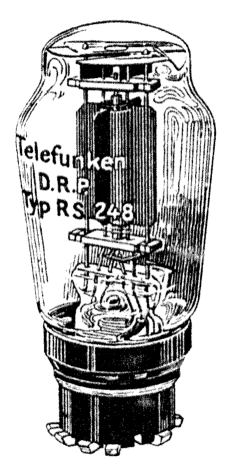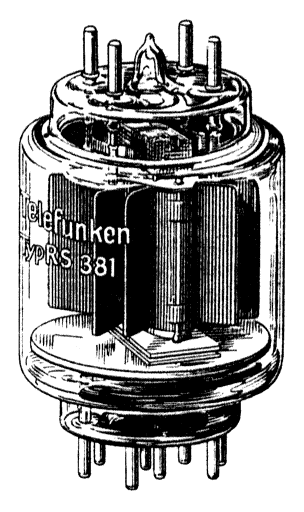| Year |
Inventor |
Invention - Discovery - Development |
| 1883 |
T. A. Edison |
Accidental discovery of emission and rectifier effects (vacuum tube) |
| 1898 |
P. Lennard |
Usage of an electrostatically operating auxiliary electrode with cathode-ray experiments |
| 1901 |
O. W. Richardson |
Electron emission theory explains Edison effect |
| 1902 |
C. Hewitt |
Relay effect by magnetic arc control (controlling an ionic discharge) |
| 1903 |
P. Lennard |
Usage of wire-mesh grids to electrostatically control electron velocity |
| 1903 |
A. Wehnelt |
Discovery of the excellent emission qualities of alkaline earths (oxide cathode) |
| 1904 |
J. A. Flemming |
Using the electron tube as a high-frequency detector |
| 1906 |
R. v. Lieben |
Vacuum amplifier tube with magnetically controlled electron flow |
| 1906 |
L. de Forest |
Detector tube with plate control |
| 1907 |
L. de Forest |
Audion patent (single-grid tube) |
| 1908 |
J. A. Flemming |
Tungsten filament for electron tubes |
| 1910 |
R. v. Lieben |
Control grid (amplifier with mercury vapor filled tube) |
| 1910 |
J. Langmuir |
Improving emission by thoriated-tungsten filament |
| 1911 |
O. v. Bronk |
Radio-frequency amplifier |
| 1912 |
AEG |
Mass production of Lieben tubes |
| 1912 |
L. de Forest |
Regeneration - positive feedback |
| 1912 |
G. Leithäuser |
Supressor-grid arrangement for cathode-ray experiments |
| 1913 |
J. Langmuir |
Space-charge grid circuit |
| 1913 |
A. Meißner |
Oscillator by positive feedback |
| 1913 |
J. Langmuir |
Significance of high vacuum for the space charge |
| 1915 |
W. Schottky |
Increasing transconductance by dual control |
| 1915 |
Schenkel |
Indirect heated cathode |
| 1916 |
W. Schottky |
Protective grid |
| 1919 |
A. W. Hull |
Screen grid |
| 1926 |
Jobst/Telegen |
Suppressor grid (pentode) |
| 1932 |
K. Steimel |
Hexode |
| 1933 |
K. Steimel |
Triode-hexode |
| Year |
Applications and design goals |
Solutions |
Tube types |
| 1923 - 1926 |
Audio-frequency amplifiers and radio-frequency detectors |
Usage of the already available tungsten-filament tubes |
RE11 |
| Reducing the heater power consumption |
Econo-tubes (dark heaters) with thoriated-tungsten filaments and oxide-coated filaments |
Thoriated: VALVO Oekonom, RE064, RE144;
Oxide: RE063, RE152 |
| 1927 |
Standardization of basing |
The "Europe" base |
all subsequently manufactured pin-socket tubes |
| Reproduction by loudspeaker |
Special output tubes |
RE134, L413 |
| 1928 |
AC power line heating |
Indirect heated tubes |
REN1004, W4110 |
| AC power line rectifying |
Rectifier tubes |
RGN1503, G1503 |
| More powerful output stage |
5-watt and 10-watt power triodes |
RE304, RE604, LK460 |
| 1929 |
Improved gain and stability on RF stages |
Screen-grid tubes |
H406D, RES044, RES094 |
| Increased plate resistance and improved grid-to-plate capacitance |
RF pentodes (screen-grid tubes with suppressor grid) |
RENS1820, H2018D |
| 1930 |
DC power line operation |
Tubes with heaters for series connection |
180-mA heater current series |
| Improving efficiency and gain of output tubes |
Power pentode |
RES174d, RES164, L416D |
| 1931 |
Simplified generation of an automatic gain control voltage |
Diodes and twin diodes (combined multi-unit tubes) |
REN924, AN4092 |
| Automatic gain control for fading compensation |
Screen-grid tubes with remote-cutoff characteristic |
RENS1214, H4125D |
| 1932 |
Improving RF amplification |
Common usage of the pentode concept for RF amplifier tubes |
RENS1264, H4111D |
| Larger audio power output |
9-watt power pentodes |
RES964, L496D |
| 1933 |
Perfecting the superheterodyne converter stage |
Hexode multiplicative mixer |
RENS1224, X4122 |
| More efficient gain control |
Fading hexodes with dual control |
RENS1234, X4123 |
| 1934 |
Gain control within the converter stage |
Mixer tubes with remote-cutoff characteristic (triode-hexode or octode) |
ACH1, AK1, BCH1 |
| 1935 |
Standardization of tube types |
Introducing the "letter" series |
A-, C-, E-series |
| Constructional improvements |
New design methods - grid cap |
AC2, AF7 etc. |
| Decreasing the heater warm-up time |
Fast heating cathode |
- |
| AC/DC operation |
Special AC/DC tubes |
C-series |
| Reduced heater power for simple AC/DC radios (VE301GW) |
Econo-tubes with 50-mA heater current |
V-series |
| Unified basing system |
Aussenkontakt socket |
A-, C-, V-series |
| Automobile radios for 6-volt and 12-volt starter battery operation |
Special automobile tubes |
E-series |
| More economical battery operation |
Battery tubes with 2-volt filaments |
K-series |
| Class-B push-pull amplifier with grid current driving |
KDD1 |
| 1936 |
Sonic improvements |
High-performance power tubes |
AD1, AL4 |
| 1937 |
Tuning indication by shadow-angle control |
Electron-ray tubes (Magic Eye) |
AM2 |
| Larger audio output for high-end radios |
18-watt power pentode |
AL5 |
| 1938 |
Uniform heater for AC, DC, and battery operation (automobile) |
Tubes with 6.3-volt heater and 200-mA current consumption |
E-section of Miniwatt series (red tubes) |
| Standardization to general-purpose usage and removal of unwanted side-effects |
Tubes of the "harmonic" series with steel enclosures (metal types) and standard bases. Electrical improvements (gliding screen-grid voltage, forward automatic gain control, lower capacitances, input and noise characteristics etc.) |
E-series with metal tubes |
| 1939 |
Simplification of the medium-range superheterodyne receiver |
Combined triode/power tetrode |
ECL11 |
| Improved tuning indication |
Dual-range indicator tube |
EM11 |
| Reducing the heater power consumption of AC/DC radios |
Special tubes of the "harmonic" series with 100-mA heater current |
U-series with metal tubes |
| 1940 |
Improving the short-wave performance by shorter electrode connections |
Tubes with integrated glass bases |
E- and U-series of the Miniwatt Loctal tubes |
| More economically battery-operated radios, circuit simplification and miniaturization |
Metal tubes - using 1.2-volt filament batteries - based on the "harmonic" principles |
D-series with metal tubes |
| Reducing the heater power consumption of AC/DC high-end radios |
Completion of the U-series |
UL12, UM11, UF11, UFM11 |
| 1945 |
Improving low-end radios at most economical power consumption |
Completion of the V-series |
VEL11 |
| 1946 |
Improving the selectivity of low-end radios by re-introduction of the small superheterodyne receiver |
Completion of the V-series |
VCH11 |
| 1947 |
Reducing the physical size, improving the VHF (FM) performance |
Miniature tubes |
E- and U-section of the Rimlock series |
| 1949 |
Improving the small superheterodyne receiver (110/220 volts change-over switch and dial illumination) |
Completion of the Miniwatt tubes by U-series types with 100-mA heater |
UCH5, UF5, UF6, UBL3, UL2, UY4 |
| Completing the U-section of the "harmonic" series |
UEL11 und UY2 |


